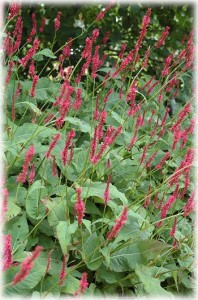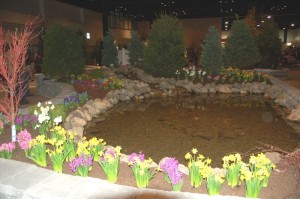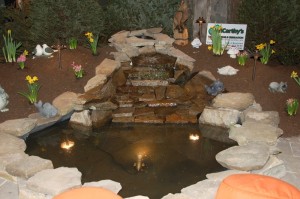 Sunday, March 4th was a fine day for driving down to see the Worcester Flower & Patio Show after a week of snowy weather. At the entrance were the winning flower arrangements of the show’s competition as well as this wonderful Cinderella carriage.
Sunday, March 4th was a fine day for driving down to see the Worcester Flower & Patio Show after a week of snowy weather. At the entrance were the winning flower arrangements of the show’s competition as well as this wonderful Cinderella carriage.
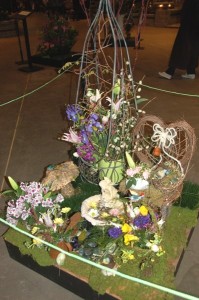
 The focus of the displays inside was on patios and all that you can do with that space. Patios certainly have come a long way from when I was growing up.
The focus of the displays inside was on patios and all that you can do with that space. Patios certainly have come a long way from when I was growing up.

Now you can have fireplaces, grills, hot tubs, comfortable dining areas as well as waterfalls and ponds.
Surrounding these are tastefully landscaped areas with shrubs, trees, perennials, and spring bulbs.
 There’s no doubt these can add a great deal of value to a home if you can afford it.
There’s no doubt these can add a great deal of value to a home if you can afford it.
The focus of the talks, however, was more on gardens and flower arranging, which were more my interest for attending.
Lecture: Top Perennial Picks by Season – Kerry Mendez
 Kerry Mendez, who lives in Ballston Spa, New York, specializes in creating organic, low maintenance gardens (www.pyours.com). Her garden at home covers a quarter of an acre and she makes the most of that space by having plants that offer not just color in spring, summer, or fall but also display interesting foliage when they’re not in bloom or provide groundcover to suppress weeds.
Kerry Mendez, who lives in Ballston Spa, New York, specializes in creating organic, low maintenance gardens (www.pyours.com). Her garden at home covers a quarter of an acre and she makes the most of that space by having plants that offer not just color in spring, summer, or fall but also display interesting foliage when they’re not in bloom or provide groundcover to suppress weeds.
She gave us a list of 54 perennials that pack a punch for a garden, large or small, and generally can be found at your local nursery. She managed to present more than half of these in the time allotted. Here are ten that I thought were interesting:
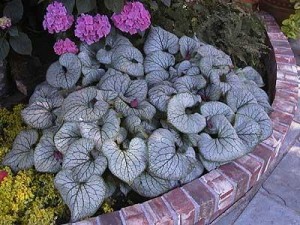 Siberian Bugloss (Brunnera ‘Jack Frost’); part shade/shade; spring bloomer; 12” tall; deer resistant; Zones 3. This is the 2012 Perennial of the Year. It has blue flowers and leaves that resemble hosta, which last through the fall.
Siberian Bugloss (Brunnera ‘Jack Frost’); part shade/shade; spring bloomer; 12” tall; deer resistant; Zones 3. This is the 2012 Perennial of the Year. It has blue flowers and leaves that resemble hosta, which last through the fall.
 Fern-Leaved Bleeding Heart (Dicentra ‘King of Hearts’); part sun/shade; spring bloomer; 8-10” tall; deer resistant; Zone 5. This actually blooms through the fall and is deer resistant. It has frosty blue leaves and looks good with hosta and Japanese Forest Grass.
Fern-Leaved Bleeding Heart (Dicentra ‘King of Hearts’); part sun/shade; spring bloomer; 8-10” tall; deer resistant; Zone 5. This actually blooms through the fall and is deer resistant. It has frosty blue leaves and looks good with hosta and Japanese Forest Grass.
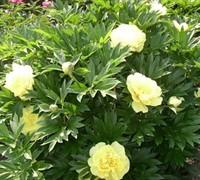 Intersectional Peony (Paeonia ‘Bartzella’); sun/part sun; spring bloomer; 30-36” tall; deer resistant; Zone 4. A hybrid of a tree peony with a traditional peony, this is easier to grow than a tree peony. Its flowers are the colors of those found in tree peonies, but holds up better in the snow than a tree peony.
Intersectional Peony (Paeonia ‘Bartzella’); sun/part sun; spring bloomer; 30-36” tall; deer resistant; Zone 4. A hybrid of a tree peony with a traditional peony, this is easier to grow than a tree peony. Its flowers are the colors of those found in tree peonies, but holds up better in the snow than a tree peony.
 Woods Phlox (Phlox divaricata ‘Louisiana Blue’); sun/part shade; spring bloomer; 12” tall; deer resistant; Zone 3. This is a highly fragrant plant that when it is done blooming, the thick and overlapping leaves suppress weeds.
Woods Phlox (Phlox divaricata ‘Louisiana Blue’); sun/part shade; spring bloomer; 12” tall; deer resistant; Zone 3. This is a highly fragrant plant that when it is done blooming, the thick and overlapping leaves suppress weeds.
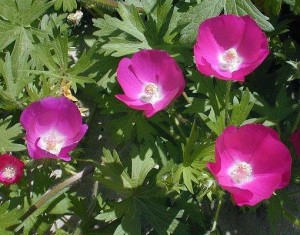 Purple Poppymallow (Callirhoe involucrata); sun; summer bloomer; 6-12” tall; Zone 4. This plant, which is drought tolerant, has a carrot tap root that sends out three long stems with mallow-like flowers. Because it is also heat resistant, it can easily cascade over retaining walls, stone walls, and paving stone in full sun. It can also be used in window boxes and hanging planters.
Purple Poppymallow (Callirhoe involucrata); sun; summer bloomer; 6-12” tall; Zone 4. This plant, which is drought tolerant, has a carrot tap root that sends out three long stems with mallow-like flowers. Because it is also heat resistant, it can easily cascade over retaining walls, stone walls, and paving stone in full sun. It can also be used in window boxes and hanging planters.
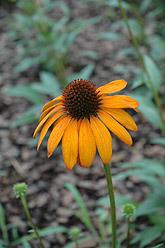 Coneflower (,Echincea ‘Tiki Torch’ ‘Sunrise’, ‘Fatal Attraction’); sun/part sun; summer bloomer; 26-36” tall; deer resistant; Zone 4. These varieties are top for hardiness and branching, and bloom into the fall. While most coneflowers don’t overwinter well, these do. Other varieties are ‘Green Jewel’, which is better than ‘Green Envy’, and ‘Milkshake’, which is white.
Coneflower (,Echincea ‘Tiki Torch’ ‘Sunrise’, ‘Fatal Attraction’); sun/part sun; summer bloomer; 26-36” tall; deer resistant; Zone 4. These varieties are top for hardiness and branching, and bloom into the fall. While most coneflowers don’t overwinter well, these do. Other varieties are ‘Green Jewel’, which is better than ‘Green Envy’, and ‘Milkshake’, which is white.
Fleeceflower (Persicaria ‘Firetail’); sun/part sun; summer-fall bloomer; 36-48” tall; Zone 4. This is a very popular plant with bright pink flowers. It blooms from July to early November and requires no deadheading! The green leaves turn to yellow in the fall. It is good for pollinators, especially bees. Pair with coneflowers and the geranium ‘Rozanne.’
 Speedwell (Veronica ‘Eveline’); sun; summer bloomer; 20” tall; deer resistant; Zone 4. Its flowerheads, which go from a white tint to purple as it grows, are larger than those of other speedwell varieties. It is good for viewing from a distance. Deadhead to prolong blooming.
Speedwell (Veronica ‘Eveline’); sun; summer bloomer; 20” tall; deer resistant; Zone 4. Its flowerheads, which go from a white tint to purple as it grows, are larger than those of other speedwell varieties. It is good for viewing from a distance. Deadhead to prolong blooming.
 Daylily (Hemerocallis ‘Going Bananas’); sun/part sun; 19-22” tall; summer-fall bloomer; Zone 3. This is an improved variety of ‘Happy Returns’ and is the best repeat bloomer. It has more flowers per stem than other varieties.
Daylily (Hemerocallis ‘Going Bananas’); sun/part sun; 19-22” tall; summer-fall bloomer; Zone 3. This is an improved variety of ‘Happy Returns’ and is the best repeat bloomer. It has more flowers per stem than other varieties.
 Yarrow (Achillea ‘Pomegranate’); sun; 24” tall; summer bloomer; deer resistant; Zone 3. This has top rating for the best red flowers and stiff stems. It is tightly mounded and has repeat blooms into the fall.
Yarrow (Achillea ‘Pomegranate’); sun; 24” tall; summer bloomer; deer resistant; Zone 3. This has top rating for the best red flowers and stiff stems. It is tightly mounded and has repeat blooms into the fall.
Kerry has written two books:
· The Ultimate Flower Gardener’s Top Ten Lists – 70 Garden-Transforming Lists, Money Saving Shortcuts, Design Tips & Smart Plant Picks for Zones 3-7
· Top Tens for Beautiful Shade Gardens – 52 Garden-Transforming Lists for Smart Plant Picks, Design Tips & Garden Shortcuts.
Both these are available at her website and on other bookseller sites, such as Amazon.
I also covered Kerry’s presentation at the Boston Flower Show last year in my blog.
Lecture: How to Build a Pond and Waterfall – Mark Packard
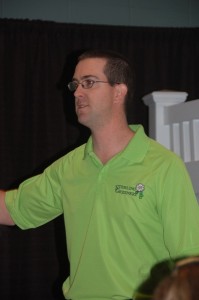 Mark Packard, of Sterling Greenery in Sterling, Massachusetts, is the number one supplier of ponds in New England. He started the presentation by answering common concerns about having a pond or waterfall on your property.
Mark Packard, of Sterling Greenery in Sterling, Massachusetts, is the number one supplier of ponds in New England. He started the presentation by answering common concerns about having a pond or waterfall on your property.
What about mosquitoes?
Mosquitoes only lay eggs in stagnant water. With Mark’s ponds the surface is always moving because of the filtration system. Also, if you have fish, they eat the larvae. Waterfalls attract natural wildlife and predators of mosquitoes, such as hummingbirds and dragonflies.
How deep should it be so it doesn’t completely freeze?
Two feet; the ground at two feet is 48 degrees. With two feet of water there will be 8” of ice.
What happens to the fish in winter?
Fish stay in the pond all winter and go into hibernation – they don’t eat.
How much electricity will it use?
For a waterfall, $10-12 per month.
How big should it be?
Make it as large as possible because more than half of the owners with ponds wish they had made it larger.
Ponds used to be made with preformed liners with pumps at the bottom. These were high maintenance and were artificial looking. The pump would get clogged and then be covered with algae so it had to be cleaned constantly.
Ponds and waterfalls are now made with 45 mil. flexible liners and a filtration system that is designed not to clog. The cost of running the filtration system is about $15 per month at 2000 GPH (gallons per hour).
You want to create a pond and/or waterfall that is part of a balanced ecosystem – be low maintenance and work with nature. The fish eat algae then the fish waste turns into nitrates that feed the plants. The plants should cover no more than 30% of the pond.
In terms of maintenance, a pondless waterfall only requires an hour per year. An 11′ x 16′ pond requires about ten hours per year of maintenance.
Mark offers a workshop for customers to show them how they can install the pond and waterfall themselves rather than pay for installation. He says homeowners can often complete the installation of an 8′ x 11′ pond with waterfall in half a day.
Also, I discovered when I visited his website that he is offering a pond and garden tour on June 23rd. See his website www.sterlinggreenery.com for more details.
Lecture: Tips to be Successful With Your Own Flower Arrangements – Sally Jablonski
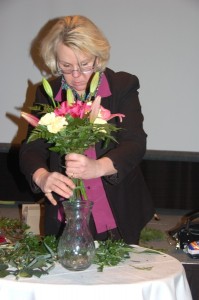 Sally Jablonski, of Herbert Berg Florists in Worcester, Massachusetts, created three flower arrangements while sharing tips for assembling and caring for the final product. Some of these tips included:
Sally Jablonski, of Herbert Berg Florists in Worcester, Massachusetts, created three flower arrangements while sharing tips for assembling and caring for the final product. Some of these tips included:
- Make sure the oasis foam has holes so the water travels to the stems faster
- Cut stems at an angle – this makes them more secure in the foam and the water travels faster through the stem
- Place an inch of stem in the foam making sure you have removed leaves
- Tropical stems last three weeks to a month
- You can grow curly willow in your yard and use the branches in arrangements
- To customize a container, you can wrap some ribbon around it, attaching it to the container with sticky dots
- For a dramatic effect, place submersible colored lights in the container with the stems. These lights can last up to 14 hours and more.
- A new way to add color to an arrangement is to insert colored wire in the foam with the stems
- To keep an arrangement fresh, change the water everyday and recut stems.
Lecture: Organic Fertilizers – Kevin Richardson
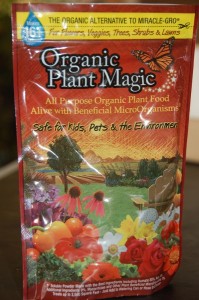 Kevin Richardson is one of the managing members of a product called Organic Plant Magic, which is an organic plant food and fertilizer. What I found interesting in Kevin’s lecture is that it is not enough to put nutrients into the soil such as dried blood or bone meal. The soil needs microorganisms that will eat and digest the nutrients. The microorganisms produce waste that is in a form that is more useful to plants not only to nourish them but to protect them from pests. See their website for more information on how to use what promises to be an amazing product.
Kevin Richardson is one of the managing members of a product called Organic Plant Magic, which is an organic plant food and fertilizer. What I found interesting in Kevin’s lecture is that it is not enough to put nutrients into the soil such as dried blood or bone meal. The soil needs microorganisms that will eat and digest the nutrients. The microorganisms produce waste that is in a form that is more useful to plants not only to nourish them but to protect them from pests. See their website for more information on how to use what promises to be an amazing product.

